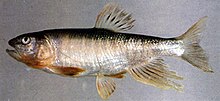
Teleostei, members of which are known as teleosts, is, by far, the largest group of ray-finned fishes, with 96% of all extant species of fish. The Teleostei, which is variously considered a division or an infraclass in different taxonomic systems, include over 26,000 species that are arranged in about 40 orders and 448 families. Teleosts range from giant oarfish measuring 7.6 m (25 ft) or more, and ocean sunfish weighing over 2 t, to the minute male anglerfish Photocorynus spiniceps, just 6.2 mm (0.24 in) long. Including not only torpedo-shaped fish built for speed, teleosts can be flattened vertically or horizontally, be elongated cylinders or take specialised shapes as in anglerfish and seahorses.

The Eurasian minnow, minnow, or common minnow is a small species of freshwater fish in the carp family Cyprinidae. It is the type species of genus Phoxinus. It is ubiquitous throughout much of Eurasia, from Britain and Spain to eastern Siberia, predominantly in cool streams and well-oxygenated lakes and ponds. It is noted for being a gregarious species, shoaling in large numbers.

The Arctic char or Arctic charr is a cold-water fish in the family Salmonidae, native to alpine lakes, as well as Arctic and subarctic coastal waters in the Holarctic.

Animal sexual behaviour takes many different forms, including within the same species. Common mating or reproductively motivated systems include monogamy, polygyny, polyandry, polygamy and promiscuity. Other sexual behaviour may be reproductively motivated or non-reproductively motivated.
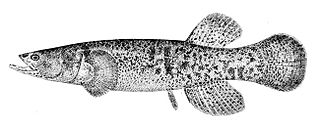
The Alaska blackfish is a species of freshwater fish in the esocid family (Esocidae) of order Esociformes. It inhabits Arctic regions of Alaska as well as Siberia and the Bering Sea islands.

Variabilichromis moorii has no common name and is a species of freshwater cichlid endemic to Lake Tanganyika in eastern Africa. It is a small ovate bodied fish named for an early collector of fish from the lake, John Edmund Sharrock Moore (1870–1947) who was a cytologist, zoologist and led an expedition to Lake Tanganyika and who discovered this species. Juveniles are usually yellow, and adults are dark brown to black in color. It reaches a total length (TL) of 10.3 centimetres (4.1 in). Currently it is the only member of its genus. V. moorii feeds on algae, zooplankton, and benthic invertebrates. It is also found in the aquarium trade.

The longnose dace is a freshwater minnow native to North America. Rhinicthys means snout fish and cataractae means of the cataract. Longnose dace are small, typically less than 100 mm and characterized by their fleshy snout that protrudes past the mouth. They are well adapted for living on the bottom of fast-flowing streams among stones. Longnose dace eat algae and aquatic insects and are important forage minnows for larger predatory fish.

Cyprinodon is a genus of pupfishes found in waters that range from fresh to hypersaline. The genus is primarily found in Mexico, the Caribbean Islands and southern United States, but C. variegatus occurs as far north as Massachusetts and along the entire Gulf of Mexico coastline, and C. dearborni and C. variegatus are found in northern South America. Many species have tiny ranges and are highly threatened, in some cases already extinct. Cyprinodon are small; the largest reaches 10 cm (3.9 in) in length and most other species only reach about half that size.

Fathead minnow, also known as fathead or tuffy, is a species of temperate freshwater fish belonging to the genus Pimephales of the cyprinid family. The natural geographic range extends throughout much of North America, from central Canada south along the Rockies to Texas, and east to Virginia and the Northeastern United States. This minnow has also been introduced to many other areas via bait bucket releases. Its golden, or xanthic, strain, known as the rosy-red minnow, is a very common feeder fish sold in the United States and Canada. This fish is best known for producing Schreckstoff.

Oncorhynchus masou formosanus, commonly known as the Formosan landlocked salmon, cherry salmon, Taiwanese trout, Tsugitaka trout, Lishan trout or Slamaw trout, is an endangered freshwater fish endemic to the mountain stream valleys between the Xueshan and Central Ranges of Taiwan. It is the southernmost subspecies of masu salmon, and one of the most tropically distributed salmonids along with the Mexican golden trout and Mexican rainbow trout.

The White Cloud Mountain minnow is a hardy species of freshwater fish and coldwater fish often kept in an aquarium. The species is a member of the carp family of the order Cypriniformes, native to China. The White Cloud Mountain minnow is practically extinct in its native habitat, due to pollution and tourism. It was believed to be extinct for over 20 years in 1980, but an apparently native population of this fish was discovered on Hainan Island, well away from the White Cloud Mountain. They are bred in farms and are easily available through the aquarium trade. However, inbreeding in farms has led to genetically weak stock that is vulnerable to disease and prone to physical deformities.
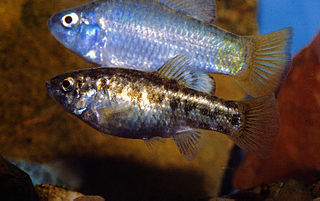
The desert pupfish is a rare species of bony fish in the family Cyprinodontidae. It is a small fish, typically less than 7.62 cm (3 in) in length. Males are generally larger than females, and have bright-blue coloration, while females and juveniles are silvery or tan. A notable attribute of the desert pupfish is their ability to survive in environments of extreme salinity, pH, and temperature, and low oxygen content. The desert pupfish mates in a characteristic fashion, wherein compatible males and females will come in contact and collectively jerk in an s-shape. Each jerk typically produces a single egg that is fertilized by the male and deposited in his territory. Breeding behavior includes aggressive arena-breeding and more docile consort-pair breeding.
The plains minnow is one of the 324 fish species found in central United States. It is a large minnow that was once a common bait fish. The plains minnow requires shallow, slow-moving streams to complete its life cycle. Pollution, dams, and introduced sport fish have caused populations to decline.

Opsariichthys is a genus of freshwater ray-finned fish belonging to the family Xenocyprididae, the East Asian minnows or sharpbellies found in freshwater habitats in Mainland China, Taiwan, Japan, Korea, and Vietnam.

The pale chub, also known as pale bleak or fresh-water sprat, is one of the most extensively distributed Asiatic cyprinids and is found in Korea, Japan, Taiwan, and most of Southeast China. This species of fish is native to freshwater rivers and mountainous streams from northern China and Korea to northern Vietnam. They can grow up to 20 centimetres (7.9 in) but usually grow to 13 centimetres (5.1 in). Its diet consists of zooplankton, invertebrates, fish, and debris. It is an invasive species in Taiwan. Zacco platypus is called Oikawaオイカワ(追河、Opsariichthys platypus) in Japan.
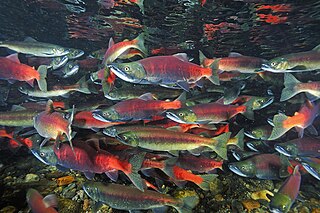
The kokanee salmon, also known as the kokanee trout, little redfish, silver trout, kikanning, Kennerly's salmon, Kennerly's trout, or Walla, is the non-anadromous form of the sockeye salmon. There is some debate as to whether the kokanee and its sea-going relative are separate species; geographic isolation, failure to interbreed, and genetic distinction point toward a recent divergence in the history of the two groups. The divergence most likely occurred around 15,000 years ago when a large ice melt created a series of freshwater lakes and rivers across the northern part of North America. While some members of the salmon and trout family (salmonids) went out to sea (anadromous), others stayed behind in fresh water (non-anadromous). The separation of the sockeye and the kokanee created a unique example of sympatric speciation that is relatively new in evolutionary terms. While they occupy the same areas and habitats during the breeding season, when ocean-going sockeye salmon return to freshwater to spawn, the two populations do not mate with each other in some regions, suggesting speciation.
Aphyocypris kikuchii is a species of freshwater ray-finned fish belonging to the family Xenocyprididae, the East Asian minnows or sharpbellies. It is endemic to Taiwan. It is a benthopelagic freshwater fish that grows to 8 cm (3.1 in) total length.

Opsariichthys evolans is a species of [freshwater ray-finned fish belonging to the family Xenocyprididae, the East Asian minnows or sharpbellies. It inhabits freshwaters of southeastern China and Taiwan. It has a maximum male length of 9.0 centimetres (3.5 in) and a maximum female length of 7.0 centimetres (2.8 in).
Opsariichthys kaopingensis is a species of freshwater ray-finned fish belonging to the family Xenocyprididae, the East Asian minnows or sharpbellies. It is endemic to southern Taiwan and has a maximum standard length of 11.4 centimetres (4.5 in). The specific name kaopingensis refers to its type locality, Kaoping River.
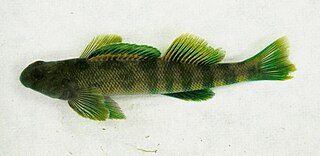
Etheostomatinae is a species-rich subfamily of freshwater ray-finned fish, the members of which are commonly known as the darters. The subfamily is part of the family Percidae which also includes the perches, ruffes and pikeperches. The family is endemic to North America. It consists of three to five different genera and well over 200 species. A common name for these fish in southern Indiana is pollywog.
